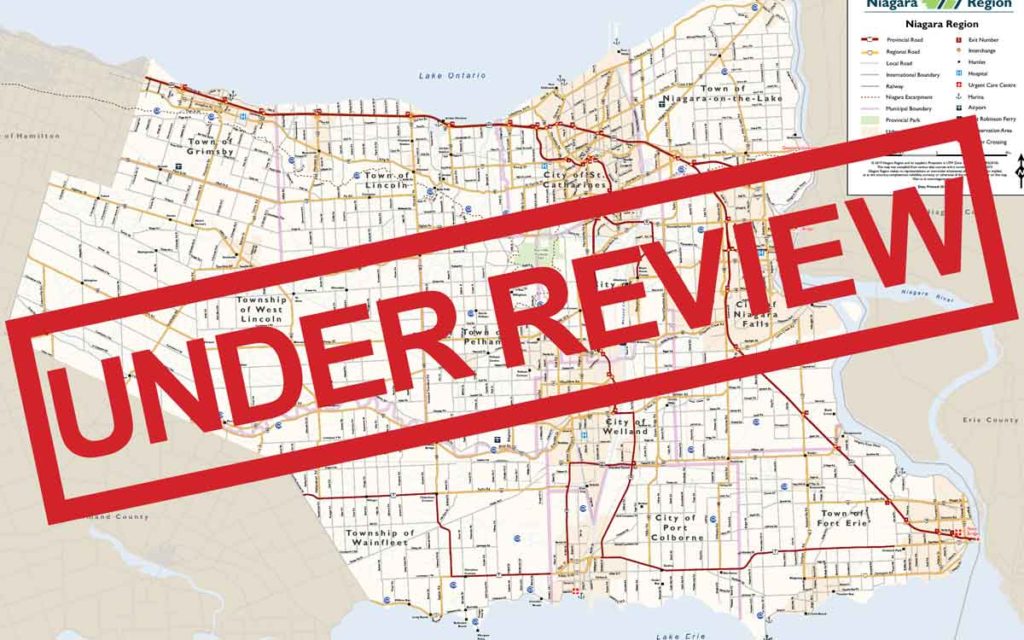
Governance review in Niagara has been a recurring topic since the Regional Municipality of Niagara was first formed 49 years ago.
The “Single City” model has been offered time and again as the magic bullet solution by many over the years. The Mike Harris Government was ready, by many reports, to do to the Niagara Region what they did to the Regional Municipality of Hamilton Wentworth in 1999 and that was to create one city of Hamilton.
Is one Niagara, meaning total amalgamation, from 12 municipalities to one city, the right solution, right now for Niagara?
The Mayo report of 1966, The Archer Report of 1977, the Kitchen Report of 1989 have all said One City Niagara is not the right solution. The Fraser Institute report of May 2015 titled, “Municipal amalgamation in Ontario”, offers some comment on amalgamations like Kawartha Lakes and Haldimand County, Norfolk County and Essex County. The recently released “Under the Knife and under the Gun” policy brief authored by Brock University’s David Siegel, Professor of Political Science, offers some facts and analysis of the option in very current terms.
The arguments in favour one city most often made locally are, fewer CAO’s (one instead of 13), fewer clerks, fewer public works directors, fewer politicians and a single economic development office with a unified strategy.
Fewer senior staff is seen as lower cost, and fewer politicians means, in theory, quicker action. Single tier should mean no duplication of services and one less layer of government. For example:
No argument over who owns the Dain City Bridge;
No argument over who is responsible for high water bills;
No arguments about the best location for a new business in Niagara;
No arguments over planning issues;
No confusion over whose road it is or who is responsible for garbage pick-up (Niagara Region took over solid waste management in 1996); and
No argument over who does social housing.
In short, no more arguments of who does what.
It is hoped that these changes would lead to lower taxes and more growth in jobs and prosperity.
An advantage of one city identified in the Brock report is Niagara speaking with one voice. We saw the power of one voice on securing GO train service to Niagara last term.
Studies have also suggested that another important potential advantage is a unified economic development strategy and the elimination of the competition between area municipalities for increased industrial and commercial tax base.
Has single tier amalgamation delivered on these items?
Two recent reports offer some comments on that question. The Brock paper released last week and the Fraser Institute report of May 2015 agree there is little evidence of reduced costs or lower taxes. In fact, there is some evidence taxes actually went up. (Found, 2012.)
The Fraser Institute report stated in its executive summary, “In our specific cases, when rural areas were amalgamated with Urban Areas, residents began to demand more urban services, which further stretched municipal budgets in the years following the initial consolidation.”
Professor Siegel’s policy brief stated, “There seems to be no evidence in Ontario or elsewhere that significant savings are achieved by amalgamations.” One reason given is, “Amalgamations increase costs by creating a ‘leveling up’ of both services and pay scales”.
A popular concern with the One City model is the loss of local identity.
Many citizens are concerned that local authority over things like planning, traffic and roads, arenas and libraries will be lost. In other words, a loss of local identity. This is more about urban politicians deciding rural issues. The fear is that local small town communities will be planned and decided by big city politicians and big city bureaucrats.
Local identity certainly has not been lost in Port Dalhousie and Merritton in St.Catharines, and Chippawa in Niagara Falls. However local authority over local land use planning has been lost and passed up to the amalgamated city of St.Catharines, as the two Port Dalhousie ward councillors can attest to. Two Port Dalhousie Condominium developments have been approved by city council, in the interest of the greater good of the City, despite the opposition of the two ward councillors.
It is the loss of local authority more than the loss of local identity that causes concern in the smaller municipalities of Niagara when single tier one city is debated.
The One City model is not popular in at least nine of 12 Niagara Municipalities and in a very unscientific on-line poll I conducted during the last municipal election, 41% said yes to one city, 53% said no, from 721 individual responses.
The question remains; is One City Niagara the right solution right now?

Bruce Timms represented St. Catharines on Niagara Regional Council from 1991 to 2018. During his near three decades in municipal politics, Timms sat on and chaired numerous committees and boards. A lifelong Niagara resident and proud Rotarian, Timms is a professional engineer and home inspector by trade.




















